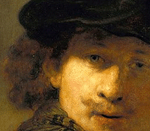
"King Solomon Receiving the Queen of Sheba"
One can see the reception of the great queen who kneels in homage before Solomon, surrounded by her gifts to him. She is beautiful, but also a delicate blond. The artist apparently expected his patrons to be more interested in pageantry than historical accuracy. Francken has represented one of her retinue as a black woman but her status appears to be secondary to the blond in more courtly attire who gathers up the queen's train and engages the viewer with her gaze. The same details can be seen in a signed version of the composition
Frans Francken the Younger is the best-known member of an extended artistic family that worked in Antwerp from the late sixteenth to the late seventeenth century. Born in 1581, he almost certainly studied with his father, Frans Francken the Elder (c. 1542-1616), before becoming a master in the Antwerp Saint Luke's Guild in 1605. In 1615/1616 he served as its deken. In 1627 he became a member of the Antwerp militia company De Oude Handboog.
Francken was an extremely productive and imaginative artist who specialized in expressively rendered small-scale religious and mythological scenes. He also painted larger altarpieces for Catholic churches. Later in his life Francken painted large altarpieces. In these works he remained immune to the influence of Rubens, whose work exercised such a strong appeal on Flemish artists of that time. His religious works are more indebted to the work of his father.
Among his religiously themed works of particular note are the unusual and stylistically 'reactionary' paintings of biblical scenes, which are framed on all sides by smaller scenes in grisaille. This type of painting had been introduced by the Antwerp artist Gillis Mostaert in the 16th century. The grisaille frame echoes the Renaissance ecclesiastical portal. Each grisaille scene has its own naturalistic perspective and as a result the compositions provide an odd mixture of three-dimensional naturalism and archaic flatness.